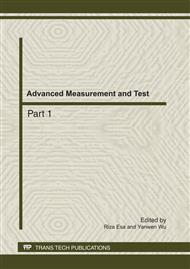[1]
Y Li, G Stuber: Orthogonal Frequency-Division Multiplexing for Wireless Communications, Springer Press, New York, USA (2006), pp.8-28.
Google Scholar
[2]
M. Russell, G. Stuber: Interchannel interference analysis of OFDM in a mobile environment. Proc. IEEE Vehicular Technology Conf. (1995), pp.820-824.
DOI: 10.1109/vetec.1995.504982
Google Scholar
[3]
P. Robertson, S. Kaiser: The effects of Doppler spreads in OFDM(A) mobile radio systems. Proc. IEEE Vehicular Technology Conf. (1999), pp.329-333.
DOI: 10.1109/vetecf.1999.797150
Google Scholar
[4]
Y. Li, L. Cimini: Bounds on the inter-channel interference of OFDM in time-varying impairments. IEEE Trans. Commun., Vol. 49 (2001), pp.401-404.
DOI: 10.1109/26.911445
Google Scholar
[5]
Taewon Hwang, Chenyang Yang and Geoffrey Ye Li: OFDM and Its Wireless Applications: A Survey. IEEE Trans. Veh. Technol., Vol. 58, No. 4(2009), pp.1673-1694.
DOI: 10.1109/tvt.2008.2004555
Google Scholar
[6]
Y S Choi, P J Voltz and F A Cassara: On channel estimation and detection for multicarrier signals in fast and selective Rayleigh fading channels. IEEE Trans. Commun., Vol. 49, No. 8(2001) , pp.1375-1387.
DOI: 10.1109/26.939860
Google Scholar
[7]
Y. Mostofi, D. C. Cox: ICI mitigation for pilot-aided OFDM mobile systems. IEEE Trans. Commun., Vol. 4, No. 2(2005), pp.765-774.
DOI: 10.1109/twc.2004.840235
Google Scholar
[8]
Baxley R. J, Kleider, J. E and Zhou G. T: Pilot Design for IEEE 802. 16 OFDM and OFDMA. IEEE International Conference on Acoustics, Speech and Signal processing, (2007), pp.321-324.
DOI: 10.1109/icassp.2007.366237
Google Scholar
[9]
Y. Mostofi, D. C. Cox: Robust and efficient intercarrier interference mitigation for OFDM systems in time-varying fading channels. IEEE Trans. Veh. Technol., Vol. 56, No. 5(2007), pp.2517-2528.
DOI: 10.1109/tvt.2007.899974
Google Scholar
[10]
Hui Chen, Xiaoguang Chen: Channel estimation for time varying channel based on decisiondirected technique in OFDM mobile systems. Journal on Communications. Vol. 28, No. 11 (2005), pp.1-5.
Google Scholar
[11]
LIU Xiao-ming, LI Dan and ZHANG Xu-ying: Training guided decision feedback equalization method for OFDM System. Journal of System Simulation. Vol. 20, No. 8 (2008), p.2007-(2010).
Google Scholar
[12]
Li, D., Feng, S. and Ye, W.: Uneven pilot-assisted channel estimation method for mobile OFDM systems. 11th IEEE Singapore International Conference on Digital Object Identifier (2008) , pp.1076-1080.
DOI: 10.1109/iccs.2008.4737348
Google Scholar
[13]
Lok Tiing Tie, Yan Wu and Kar Peo Yar: Performance Evaluation of Mesh-based Mobile WiMax PHY Baseband for Above the Sea Propagation. 2010 European Wireless Conference (2010), pp.83-87.
DOI: 10.1109/ew.2010.5483398
Google Scholar
[14]
Jeon W G, Chang K H and Cho Y S: An Equalization Technique for Orthogonal Frequency-division Multiplexing Systems in Time-variant Multipath Channels. IEEE Trans on Communications. Vol. 47, No. 1 (2008), pp.27-32.
DOI: 10.1109/26.747810
Google Scholar


